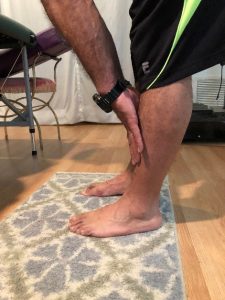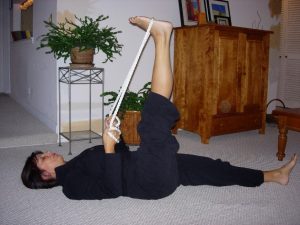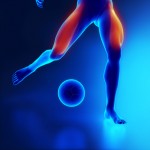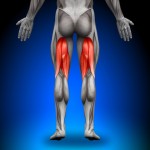 One more hot month to go! This has been an exceptionally hot summer in many places around the USA. In fact, many times Florida was cooler (mid 90’s) than some of the cities up north. Weird!
One more hot month to go! This has been an exceptionally hot summer in many places around the USA. In fact, many times Florida was cooler (mid 90’s) than some of the cities up north. Weird!
I hope you are doing well as this COVID19 problem keeps hanging around to make our lives a challenge. When the shutdown happened back in March, I didn’t know what I was going to do. As you are well-aware, I don’t do relaxing massage, I work with people who are in real pain. How do I tell people to just be in pain until this pandemic passes!
Fortunately for me, and for my clients, the first client I saw after the shutdown was a medical doctor. I asked her about people coming to me and she told me if everyone wears a mask, and I wash my hands before and after treating someone, that it would be fine. So that’s what’s been happening. Plus, I wash everything down with a strong disinfectant after each client, and all is well.
I’m seeing less people, but I’m seeing people who are in a lot of pain and are desperate for help. As my clients have told me, I am an essential worker, and I believe they are right.
With that said, I want to tell you about a man who drove 17 hours from southern Texas to work with me for a week. Let’s call him JT for privacy.
You Can Touch Your Toes Again
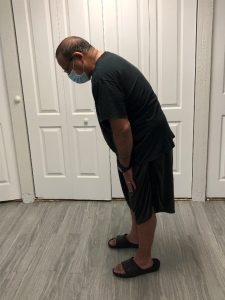 JT was stiffer than anyone I’d ever seen in the past, and after a 17-hour trip, we knew he needed to come in a LOT. He ended up coming in for 3 hours a day for the first 3 days, and 90 minutes on Thursday and Friday.
JT was stiffer than anyone I’d ever seen in the past, and after a 17-hour trip, we knew he needed to come in a LOT. He ended up coming in for 3 hours a day for the first 3 days, and 90 minutes on Thursday and Friday.
When JT arrived, it amazed me at how stiff his pelvis was, every muscle that moved his pelvis, legs and low back were tied up in multiple tight knots. He has given me permission to share his pictures with you so I can explain something really interesting that I found, and how it can help you to release tension in your low back.
Day 1: JT’s hips were so locked that when he bent forward his fingertips only went to 7” above his knees. He couldn’t bend any further than this!
I’ve already shown you how to do the self-treatment for your quadriceps using a 12”x1” length of PVC pipe, and how to use the Perfect Ball on your low back muscle. This is where we started so the muscles that rotate the pelvis down in the front can start to release.
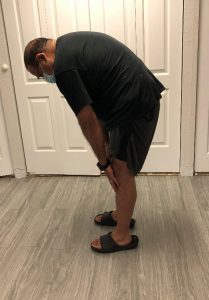 Day 2: First I worked on all of the muscles that insert into his thigh bone where it inserts into his pelvis. Then JT used the Perfect Ball and working on the floor he went deeply into all of the muscles that connect his pelvis to his thigh bone.
Day 2: First I worked on all of the muscles that insert into his thigh bone where it inserts into his pelvis. Then JT used the Perfect Ball and working on the floor he went deeply into all of the muscles that connect his pelvis to his thigh bone.
At the end of the day his fingers were 5” below his knee joint.
On Day 3 there was a set-back, his fingers were still about 2” below his knee joint but we were questioning what we were missing. When JT bent forward, he had pain in the front of his pelvis, just below the point of his hip bone. That’s an area that definitely shouldn’t be hurting when JT bent forward. I kept looking at my skeleton, Max, and my book of muscles/bones/joints, to try to figure it out, and looking at the muscles of the pelvis. Then suddenly it was so clear!
Your hamstrings originate at the base of your posterior pelvis, and they insert just below the back of your knee. Your thigh bone (femur) inserts into your hip at an area called the acetabulum, it looks like fitting a ball into a curved cup.
This is the part I want to share with you today.
How Your Hamstrings Impact Your Pelvis
On the afternoon of Day 3, I was frustrated at the set-back. After staring at Max and my book of muscles it finally dawned on me that it was JT’s hamstrings that were part of the problem, even though it was his rotating pelvis that was causing his hip joint to be out of alignment.
I had been working on all of the pelvic muscles and they all felt pretty good, and I had done a pass down the back of his thighs, but I hadn’t focused on JT’s hamstrings. And that made all the difference!
An important point to mention when talking about a long-standing problem with tight muscles is to discuss “muscle memory.”
Muscle memory is when a muscle that has been held shortened for an extended time (which could be just a few hours) it will shorten to that new length. The problem is, you release the tension in the muscles and get relief, but the muscle shortens again, and the strain is again placed on your joints.
As JT’s hamstrings shortened, they pulled down of the back of his pelvis, and this twisted the alignment of his hip joint. Because of this misalignment, he was feeling pain in the front of his hip, and that was the piece I’d been missing.
After treating JT’s hamstrings (treatment shown below) he was able to bend almost all the way to his ankles! Only three days before JT could only bend to not even the middle of his thigh, yet here he was almost to his ankles!
Treating Hamstrings To Relax The Pelvis
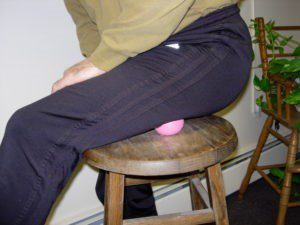 If you have been to my therapy office, you know that I always teach how to do 1-2 self-treatments. The reason is you need to reverse muscle memory, and the only way to do that is to do the self-treatments frequently – every day is best.
If you have been to my therapy office, you know that I always teach how to do 1-2 self-treatments. The reason is you need to reverse muscle memory, and the only way to do that is to do the self-treatments frequently – every day is best.
A simple way of treating your hamstrings is to put a Perfect Ball on a wooden chair, or the corner of a desk, and put your hamstrings onto the ball.
Keep moving the ball until you find tender points as these are the knots (spasms) that are putting a strain on your pelvis. Treat each point and then stretch
Stretching Your Hamstrings
Lie on your back and put a rope under your arch. Start with your knee bent and lift your leg up as high as you can go without seriously straining your hamstrings.
Slowly straighten your leg, stretching your hamstrings.
Day 5 – JT is Ready to Go Back to Texas
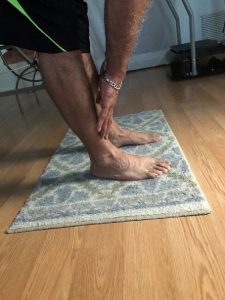 JT is now only 3” above the top of his foot. He’s not touching his toes yet, but he feels so much better.
JT is now only 3” above the top of his foot. He’s not touching his toes yet, but he feels so much better.
The best news is that JT is thoroughly familiar with every self-treatment to release all of the muscles that have an impact on his pelvis. He’s not 100% better yet, but he’s well on his way.
How Does This Affect You?
The important part of this story for you is that you CAN learn how to self-treat, and the odds are excellent that you can get relief from even the most stubborn of chronic pains.
My goal is to help as many people as possible to eliminate chronic pain that is caused by tight muscles, and to show they how to self-treat!
Wishing you well,
Julie Donnelly
These statements have not been evaluated by the Food and Drug Administration. This information is not intended to diagnose, treat, cure or prevent any disease.

